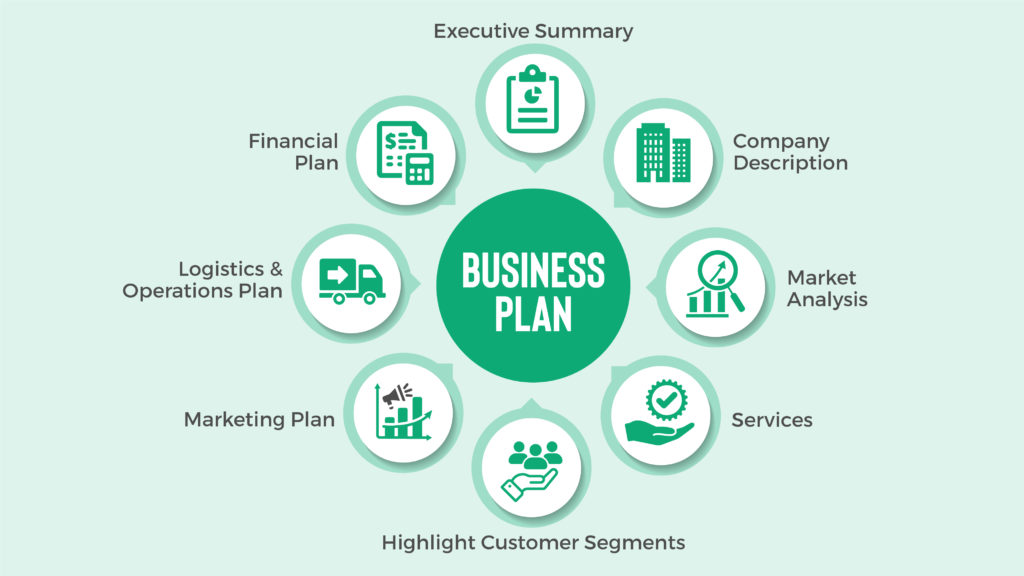Your business plan is a great way to organize and provide a map to make your business idea a reality. It’s an essential component of raising finance and attracting investors, business partners, or managers.
According to Harvard Business Review, the most successful entrepreneurs write their business plan between six to twelve months after deciding to start their business, increasing their venture viability success by 8%. Venture viability odds rose by 27% for entrepreneurs who created their plans in the early days of speaking to customers and preparing marketing.
Having said that, it’s never too late or too early to start writing your plan. We’ll provide a rough outline, as well as some links to a free business plan template for you to follow.
Completing Your Business Plan Template

Business plans can vary based on your intention or their application. Writing a business plan for internal use differs from presenting a solid business plan to a bank or investor. In this section, we’ll show you how to write a plan that’s suitable for most applications, and you can make adjustments according to your needs.
Write the Executive Summary
You’ll want to create this section upfront to guide your document or write it at the end to summarize your finished plan. Highlight the key points you will cover in the document, including your business concept, goals, and vision. If you sell a product, describe what it does and how it’s different from competitor products. Include a short summary of your target market, financial projections, marketing strategy, and the purpose of your business plan.
Provide a Company Description
This section has to answer who you are and what you do. Explain why you are in business, what makes your business different, and what your strengths are. You may want to include a short overview of your team and why you feel that you’re a solid choice for investors, including a summary of your track record or experience.
Your company description should include details like:
- Your business structure (sole proprietorship, general partnership, incorporation, etc.)
- Your business model
- Your industry
- Your vision, mission, and values statement
- Background information about the business to date
- The long and short-term objectives
- Your team
Complete a Thorough Market Analysis
Choosing the wrong target market can break a business. Market research should form a key section in your business plan, whether you intend to share it externally or not. This section should include the following:
- An overview of your target customers and ideal customer profile, as well as the size of the target group;
- An overview of relevant industry trends and trajectory, including consumption patterns;
- A SWOT analysis detailing your strengths, weaknesses, opportunities, and threats in a grid format;
- A competitive analysis that demonstrates how your business is differentiated from the competition, e.g. cost leadership, unique value proposition, or your segmentation strategy.
List Your Products or Describe Your Services
The Product section outlines key details about your products or service. If you sell multiple products, it’s important to include general information about each product line without going into granular detail. You can include details about possible new products or product line expansions in this section as well.
Highlight Customer Segments
Unless you sell extremely niche products, you’ll likely promote your business to various customer segments. Provide a holistic view of your ideal customer, along with general and specific demographic characteristics, including where customers live, their age range, level of education, their average income, and general information related to their values, beliefs, and opinions.
Draft Your Marketing Plan
Once you’ve determined which customer segments you’d like to target, you can share your strategy for reaching and converting those customers. Most business plans split the marketing portion into four sections or elements of the marketing mix:
- Price: How much will you charge for your products and services, and how did you determine that amount?
- Product: Why does your product appeal to the market, and what differentiates it from the competitors?
- Promotion: How will you raise awareness among your target market about your product or service?
- Place: Where and how will products be sold and distributed?
Promotion should contain all the tactical details related to your current and future marketing efforts, but all four areas are important.
Share Your Logistics and Operations Plan
If you sell products, where you house your inventory and how you will distribute it is an important component of your business plan. In this section, highlight the workflows you will use to succeed, including:
- Details related to your suppliers
- Production details, including your manufacturing strategy
- Facilities you may own or rent
- Equipment, including the tools and technology you require or already use
- Your shipping and fulfillment plan
- Your inventory plan, including storage and shipping details.
This section should not only demonstrate your knowledge of the industry but give readers an indication of the contingency plans you have in place to manage uncertainty in the future. Include some details related to your pricing strategy and your break-even point.
End with Your Financial Plan
The level of detail you include in this section will depend on who you want to present your business plan to and your end goal. At the very least, this section should contain income statements, balance sheets, and cash flow statements with as many details as practical. Typically, financial projections will be included here and form an important part of most business plans.
Tips For Writing The Perfect Business Plan

Business planning is vitally important for startups and established businesses alike. Even if you have no intention of sharing your business plan with outsiders, business plans can provide guidance and direction. When you write your plan, keep the following tips in mind:
Stay Concise
If you can’t explain what your business is and what it does concisely, chances are investors (and customers) will have a hard time understanding it down the line. Writing a short executive summary explaining what you do and how you will become profitable is a good first step.
Be Specific
You won’t secure funding with vague statements. Back up your plans with data and research. You need to demonstrate how you will complete your business objectives in a clear, actionable fashion.
Research Your Market
Make sure that you understand who your target market is. You should know who you are selling to, what their pain points are, and how many companies are already selling similar products.
Do The Math
It doesn’t matter what kind of business you are in, your end goal should always be turning a profit. Make sure you know exactly what your costs are, what level of investment is required, and how you will apply for the funding in the business.
Free Business Plan Templates
There are several free templates to choose from online. Score offers a free template for non-profit organizations, while the US Small Business Administration (SBA) offers a traditional business plan you can complete online and download as a PDF. (You can make edits to the document at any time).
The $100 Startup offers a short and succinct one-page business plan template, while the Law Depot offers industry-specific templates.
If you’re considering getting into the distribution business, come check out how 10X ERP can give you a competitive advantage through modern, intuitive ERP software.
